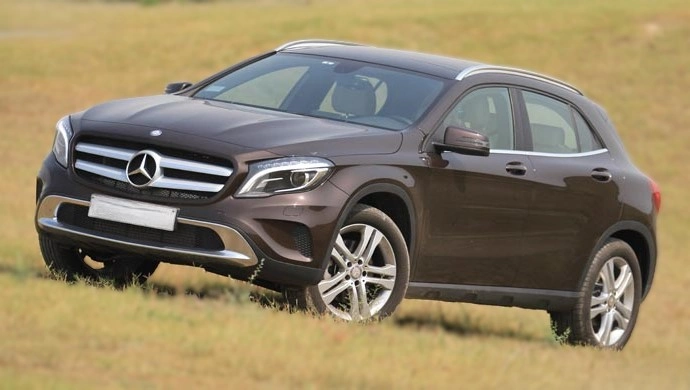This About Mercedes Benz GLA 200
The Mercedes-Benz GLA 200 Sport, part of the first-generation GLA-Class (X156), was produced between 2014 and 2020. This premium compact SUV combines sporty aesthetics with practicality, making it a popular choice for urban dwellers and small families.
Features
- Engine:
- 1.6L inline-4 turbocharged petrol engine.
- Produces 156 hp and 250 Nm of torque.
- Transmission:
- 7-speed dual-clutch automatic transmission (7G-DCT).
- Interior:
- Premium ARTICO leather upholstery with contrast stitching.
- 8-inch infotainment display with Bluetooth, USB, and navigation.
- Dual-zone automatic climate control.
- Electrically adjustable front seats with memory function.
- Ambient lighting with selectable colors.
- Safety:
- 6 airbags, ABS with EBD, and ESP (Electronic Stability Program).
- Attention Assist and Collision Prevention Assist.
- Active Parking Assist with a rearview camera.
- Exterior:
- Diamond-pattern grille with chrome highlights.
- Bi-xenon headlamps with LED DRLs (later models feature LED headlamps).
- 18-inch alloy wheels with a sporty design.
- Roof rails and integrated rear spoiler.
Reliability
- The GLA 200 Sport is known for its reliability with proper maintenance.
- The turbocharged engine is efficient and performs well under regular servicing.
Performance
- Acceleration: 0–100 km/h in 8.1 seconds.
- Top Speed: 215 km/h.
- Driving Dynamics:
- Smooth power delivery with sporty handling.
- Compact dimensions make it ideal for city driving.
- Suspension tuned for a balance between comfort and agility, though slightly firm over rough roads.
Maintenance Costs
- Annual Maintenance Cost: ₹70,000–1,00,000 (depending on usage and condition).
- Typical Service Costs:
- Regular Service (oil, filters, etc.): ₹15,000–20,000.
- Brake Pads Replacement: ₹20,000–25,000.
Fuel Efficiency
- City Driving: 12–14 km/l.
- Highway Driving: 16–18 km/l.
- Combined Efficiency: 14–16 km/l.
Periodic Maintenance
- Oil and Filter Change: Every 10,000 km or 1 year.
- Air Filter Replacement: Every 20,000 km.
- Brake Fluid Replacement: Every 2 years.
- Coolant Replacement: Every 3 years or 50,000 km.
- Transmission Fluid Replacement: Every 60,000 km.
Major Service Intervals
- 40,000 km Service: Includes oil change, air filter replacement, and brake inspection. Approx. ₹30,000–40,000.
- 80,000 km Service: Includes all the above, plus transmission fluid replacement and suspension check. Approx. ₹50,000–60,000.
- 1,20,000 km Service: Comprehensive service with diagnostics. Approx. ₹70,000–80,000.
Common Problems
- Suspension Noise:
- Symptoms: Loss of power or excessive smoke.
- Solution: Turbocharger repair or replacement (₹1,00,000–1,50,000).
- Turbocharger Wear:
- Symptoms: Loss of power or excessive smoke.
- Solution: Turbocharger repair or replacement (₹1,00,000–1,50,000).
- Electrical Glitches:
- Symptoms: Infotainment or sensor issues.
- Solution: Software updates or component replacement (₹10,000–20,000).
- Brake Wear:
- Symptoms: Reduced braking efficiency or noise.
- Solution: Brake pad and disc replacement (₹20,000–30,000).
Parts Cost (Approximate)
- Engine Oil and Filter: ₹10,000–15,000.
- Air Filter: ₹5,000–8,000.
- Brake Pads (Front and Rear): ₹20,000–25,000.
- Battery: ₹60,000–70,000.
- Turbocharger Repair: ₹1,00,000–1,50,000.
Market Value (2024–2025)
- Price Range: ₹20 lakhs–25 lakhs (depending on mileage, condition, and features).
- Depreciation: Retains value moderately well due to its premium brand and practicality.
- Future Trends: Demand remains steady for compact luxury SUVs with efficient engines.

The Mercedes-Benz GLA 200 Sport (X156) is a well-rounded compact SUV offering luxury, practicality, and sporty performance. Its stylish design and premium features make it an attractive option for urban buyers. Ensure regular maintenance and thorough inspection of the turbocharger and suspension when purchasing a pre-owned model.
What is the mileage of a Mercedes GLA 200?
The Mercedes GLA 200 offers an average mileage of approximately 17.4 km/l for the petrol variant, as per ARAI-certified figures. Real-world mileage may vary based on driving conditions, typically ranging from 14–16 km/l.



